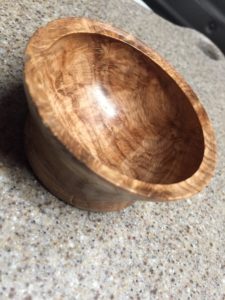I’m sure all of us have enjoyed the craftsmanship of a woodworker displayed in a finely turned bowl or candlestick holder. My brother Dale has an incredible gift to work with wood and regularly produces items of exquisite beauty from his hands and his lathe. I have been fortunate to be on the receiving end of some of his creations.
One characteristic that enhances a turned product is the swirling of the wood grain known as a burl. These unique designs in the wood create incredibly beautiful patterns highlighted in the finished item. Although the irregularities in the grain sometime pose difficulties for lathe workers, sharp chisels and prolonged patience will yield results worth the perseverance.
Burls, however, are abnormalities within otherwise normal trees. In most cases, botanists have discovered that burls are formed when dormant buds grow inward instead of outward. Rather than exiting the bark and developing leaves to produce sugars for tree growth like most twigs, they twist and turn beneath the bark causing curvy lines resembling those on a West Virginia topographic map. 
These oddities form due to a variety of factors including physical injury caused by insect damage, another tree, or a neighboring limb. Other factors such as temperature stresses as well as lack of sunlight, nutrients, or moisture have also have been shown to produce these unique formations.
Some tree species such as maple, oak, and pine, seem to develop burls more frequently than others and so it appears that genetics may play a role. Even disease organisms are suspect although the wood and tree itself remain healthy. Perhaps the growth of this structure helps the plant withstand the injury and survive with only the burly scar left behind.
All of these factors are of great concern to the tree itself. But because of God’s creative genius in designing trees to successfully respond to these otherwise threatening situations, what should have damaged or killed the tree ended up producing something of special beauty and added value.
The same Designer who created the trees created us. In His infinite wisdom, God fashioned us with the ability to respond to the extremely varied pressures of life with resolve and resiliency. He has provided us with the spiritual, emotional, and volitional ability to not only resist and overcome such threats, but to become more beautiful as a result. Unfortunately, many times we only view hardships as curses and allow them to steal our joy and victory.
Jacob’s son, Joseph, illustrates for us how God can turn otherwise damaging life events into something for His glory and our good. After his brothers sold him into slavery, God raised him up to lead Egypt and eventually save their own lives by providing them with much needed food during a severe famine. When he and his brothers were reunited and the balance of power reversed, instead of exacting revenge, Joseph declared, “You intended to harm me, but God intended it for good.”
Paul also reinforces this concept in Romans 8:28 where he assures us that in all things God works for the good of those who love him and who have been called according to his purpose. God can use the harm caused intentionally by others, by accidental disasters, or by debilitating disease to produce beautiful qualities in our lives that enable us to be more useful and beautiful to Him as well as to our fellowman.
The next time we’re tempted to consider some hardship as only detrimental, let’s remember the tree burls and invite God to do His beneficial work within us to produce something of value and beauty.
In Jesus, .George